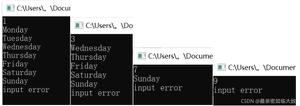C++中N-Ary树的深度?
让我们首先定义表示包含字符键和 Node * 向量的树节点的结构。
struct Node{ char key;
vector<Node *> children;
};
接下来我们创建我们的createNode(int key)函数,它接受一个 int 键值并将其分配给节点的键成员。该函数返回指向创建的结构节点的指针。
Node *createNode(int key){ Node *node = new Node;
node->key = key;
return node;
}
我们的 depthOfTree(struct Node* root) 函数将根节点作为参数。如果根为 NULL,则深度返回为 0。
int depthOfTree(struct Node *root){ if (root==NULL)
return 0;
然后我们定义 maxDepth 变量并将其值赋值为 0。然后我们遍历树的所有子节点并在每次递归时增加 maxDepth。一旦满足基本条件并且递归结束,我们就会返回 maxDepth。
int depthOfTree(struct Node *root){ if (root==NULL)
return 0;
int maxDepth = 0;
for(auto i: root->children){
maxDepth = depthOfTree(i) + 1;
}
return maxDepth;
}
示例
让我们看看下面的实现来找到 N-Ary 树的深度 -
#include <iostream>输出结果#include <vector>
using namespace std;
struct Node{
char key;
vector<Node *> children;
};
Node *createNode(int key){
Node *node = new Node;
node->key = key;
return node;
}
int depthOfTree(struct Node *root){
if (root==NULL)
return 0;
int maxDepth = 0;
for(auto i: root->children){
maxDepth = depthOfTree(i) + 1;
}
return maxDepth;
}
int main(){
Node *root = createNode('S');
(root->children).push_back(createNode('O'));
(root->children).push_back(createNode('A'));
(root->children).push_back(createNode('D'));
(root->children).push_back(createNode('N'));
(root->children[0]->children).push_back(createNode('L'));
(root->children[0]->children).push_back(createNode('I'));
(root->children[2]->children).push_back(createNode('R'));
(root->children[3]->children).push_back(createNode('C'));
(root->children[3]->children).push_back(createNode('H'));
(root->children[3]->children).push_back(createNode('I'));
cout <<"The depth of the n-ary tree is "<< depthOfTree(root) << endl;
return 0;
}
上面的代码将产生以下输出 -
The depth of the n-ary tree is 2
以上是 C++中N-Ary树的深度? 的全部内容, 来源链接: utcz.com/z/317486.html









